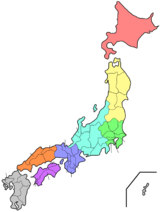Kagoshima Prefecture
Kagoshima Prefecture (鹿児島県, Kagoshima-ken) is a prefecture of Japan located on the island of Kyushu and the Ryukyu Islands.[1] The capital is the city of Kagoshima.[2]
Kagoshima Prefecture 鹿児島県 | |
|---|---|
| Japanese transcription(s) | |
| • Japanese | 鹿児島県 |
| • Rōmaji | Kagoshima-ken |
 Flag  Symbol | |
 | |
| Country | Japan |
| Region | Kyushu |
| Island | Kyushu |
| Capital | Kagoshima |
| Subdivisions | Districts: 8, Municipalities: 43 |
| Government | |
| • Governor | Satoshi Mitazono |
| Area | |
| • Total | 9,187.01 km2 (3,547.12 sq mi) |
| Area rank | 10th |
| Population (January 1, 2020) | |
| • Total | 1,599,779 |
| • Rank | 24th |
| • Density | 170/km2 (450/sq mi) |
| ISO 3166 code | JP-46 |
| Website | www |
| Symbols | |
| Bird | Lidth's jay (Garrulus lidthi) |
| Flower | Miyamakirishima (Rhododendron kiusianum) |
| Tree | Camphor laurel (Cinnamomum camphora) |
History
Kagoshima Prefecture corresponds to the ancient Japanese provinces Ōsumi and Satsuma, including the northern part of the Ryukyu Islands (Satsunan).[3] This region played a key role in the Meiji Restoration (Saigō Takamori), and the city of Kagoshima was an important naval base during Japan's 20th century wars and the home of admiral Tōgō Heihachirō. More recent incidents are the sinking of a North Korean spy ship (100 ton class) in 2001 by the Coast Guard, which was later salvaged and exhibited in Tokyo, and the abduction of an office clerk from a Kagoshima beach in 1978 by agents from the same country. This became known only recently under the Koizumi administration.
Demographics
The two main ethnic groups of Kagoshima Prefecture are the Japanese and the Ryukyuans (Amami Islands).
Geography
Kagoshima Prefecture is located at the southwest tip of Kyushu on the Satsuma Peninsula and Ōsumi Peninsula. This prefecture also includes a chain of islands stretching further to the southwest of Kyushu for a few hundred kilometers. The most important group is the Amami Islands. Surrounded by the East China Sea to the west, Okinawa Prefecture in the south, Kumamoto Prefecture to the north, and Miyazaki Prefecture to the east, it has 2,632 km of coastline (including the 28 islands). It has a bay called Kagoshima Bay (Kinkowan), which is sandwiched by two peninsulas, Satsuma and Ōsumi. Its position made it a 'gateway' to Japan at various times in history. While Kyushu has about 13 million people, there are less than 2 million in this prefecture.
The prefecture boasts a chain of active and dormant volcanoes, including the great Sakurajima, which towers out of the Kagoshima bay opposite Kagoshima city. A steady trickle of smoke and ash emerges from the caldera, punctuated by louder mini-eruptions on an almost daily basis. On active days in Kagoshima city an umbrella is advisable to ward off the ash. Sakurajima is one of Japan's most active volcanoes. Major eruptions occurred in 1914, when the island mountain spilled enough material to become permanently connected to the mainland, and a lesser eruption in 1960. Volcanic materials in the soil make Sakurajima a source for record daikon radishes, roughly the size of a basketball. Many beaches around the Kagoshima Bay are littered with well-worn pumice stones. A crater lake in the southwestern tip of the prefecture, near the spa town of Ibusuki, is home to a rare species of giant eel.
As of 31 March 2019, 13% of the total land area of the prefecture was designated as Natural Parks, namely the Amami Guntō, Kirishima-Kinkowan, Unzen-Amakusa, and Yakushima National Parks; Koshikishima and Nichinan Kaigan Quasi-National Parks; and Akune, Bōnoma, Fukiagehama, Imutaike, Ōsumi Nanbu, Sendaigawa Ryūiki, Takakumayama, and Tokara Rettō Prefectural Natural Parks.[4][5]
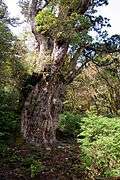 Jōmon Sugi in Yaku Island
Jōmon Sugi in Yaku Island- Mangrove native forest in Amami Island
- A crane observation centre in Izumi crane migration grounds
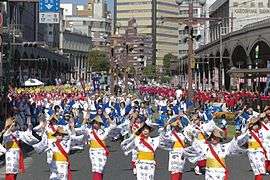 Ohara style folk dance in Kagoshima Ohara Festival in November
Ohara style folk dance in Kagoshima Ohara Festival in November- Sand bath style in Ibusuki Spa
Economy
Most of the economic sector is focused in Kagoshima City and the surrounding area, corresponding to the extent of the former Satsuma Province. The eastern part of the prefecture, the former Ōsumi Province, is mostly rural and shows a general population decline.
The prefecture has strong agricultural roots, which are reflected in its most well-known exports: green tea, sweet potato, radish, Pongee rice, Satsuma ware and Berkshire pork ("kurobuta"). Kagoshima prefecture's production of bonito flakes is second only to that of Shizuoka. In addition it produces Japan's largest volume of unagi eels.
The Japan Aerospace Exploration Agency (JAXA) has several facilities within the prefecture, including the country's main launch facility on Tanegashima and the Uchinoura Space Center.
The prefecture's gross domestic product is approximately 4.834 trillion yen.
Municipalities
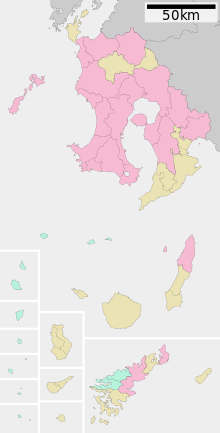
City Town Village
The following is a list of Kagoshima Prefecture's cities, and its administrative districts with their constituent towns and villages:
Cities
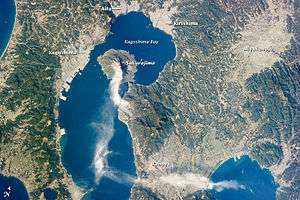
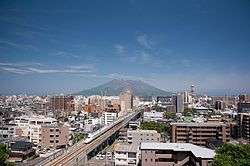
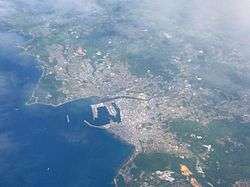
Nineteen cities are located in Kagoshima Prefecture:
- Kagoshima (the capital city of the prefecture)
- Aira
- Akune
- Amami
- Hioki
- Ibusuki
- Ichikikushikino
- Isa
- Izumi
- Kanoya
- Kirishima
- Makurazaki
- Minamikyushu
- Minamisatsuma
- Nishinoomote
- Satsumasendai
- Shibushi
- Soo
- Tarumizu
Districts
These are the towns and villages in each district:
Mergers
Sport and recreation
Kagoshima Rebnise, a professional basketball team, was founded in 2003 and currently competes in the second division of the national B.League. Kagoshima United FC, a soccer team, was founded in 2014 and competes in the J3 League. Although no major professional baseball teams are based in the prefecture, a number of Kagoshima's ballparks have hosted the spring training camps of Nippon Professional Baseball teams:
- Kamoike Ballpark, previous camp home of the Chiba Lotte Marines (NPB) and Lotte Giants (KBO League). Also hosts regular season games.
- Kamoike Citizen Stadium
- Ibusuki Municipal Ballpark (指宿市営球場), camp home of the Kokutesu Swallows
- Yunomoto Ballpark (湯之元球場), camp home of the Yakult Atoms
- Kagoshima Kamoike Stadium, camp home of Júbilo Iwata (soccer) and Toshiba Brave Lupus (rugby)
- Kagoshima Fureai Sportsland, camp home of Sagan Tosu (soccer)
The Kirishima-Yaku National Park is located in Kagoshima Prefecture.
Colleges and universities
- Kagoshima University
- National Institute of Fitness and Sports in Kanoya
- The International University of Kagoshima
- Kagoshima Immaculate Heart University
- Daiichi Institute of Technology
- Shigakukan University
- Kagoshima Prefectural College
- Kagoshima Immaculate Heart College
- Kagoshima Women's Junior College
- Daiichi Junior College of Infant Education
Science and technology facilities
Museums
Transportation

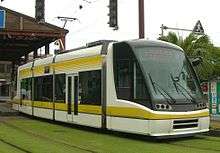
Rail
- JR Kyushu
- Hisatsu Orange Railway
Trams
- Kagoshima City Tram
Roads
Expressways and toll roads
- Kyushu Expressway
- Miyazaki Expressway
- Ibusuki Toll Road
- Minamikyushu Expressway
- Higashikyushu Expressway (Hayato Road)
National Highways
- National Route 3 (Kitakyushu–Fukuoka–Kurume–Kumamoto–Minamata-Izumi-Satsuma Sendai-Kagoshima)
- National Route 10 (Kitakyushu-Nakatsu–Beppu–Saiki–Nobeoka–Miyazaki–Miyakonojo-Kagoshima)
- National Route 58 (disconnected segments in downtown Kagoshima and on the islands of Tanegashima and Amami Ōshima)
- Route 220 (Miyazaki-Nichinan-Shibushi-Kanoya-Tarumizu-Kirishima)
- Route 223
- Route 224
- Route 225
- Route 226
- Route 267 (Hitoyoshi-Isa-Satsuma Sendai)
- Route 268 (Minamata-Isa-Ebino–Kobayashi-Miyazaki)
- Route 269
- Route 270
- Route 328 (Kagoshima-Isa-Izumi)
- Route 389 (Ōmuta–Tamana–Unzen–Minamishimabara–Amakusa-Akune)
- Route 447 (Ebino-Isa-Izumi)
- Route 448
- Route 499
- Route 504 (Kanoya-Kirishima-Satsuma-Izumi)
Ports
- Kagoshima Port
- Domestic ferry route to Sakurajima, Kikai Island, Tokunoshima, Amami Island, Tanegashima, Yakushima, Yoron Island, Okinoerabu and Naha.
- High-speed craft route to Ibusuki, Tanegashima and Yakushima.
- International container hub port
- Shibushi Port
- Naze Port
- Ferry Route to Osaka, Kobe, Kagoshima, Yakushima, Tanegashima, Tokunoshima and Naha.
- Yakushima Port
- Tanegashima Port
- Tokunoshima Port
Airports
- Kagoshima Airport
- Amami Airport
- Tokunoshima Airport
- Tanegashima Airport
- Yakushima Airport
- Okinoerabu Airport
- Yoron Airport
Notable people
- Isamu Akasaki, scientist, Nobel Prize in Physics laureate
- Hajime Chitose, singer
- Yasuhito Endo, football player
- Kosuke Fukudome, MLB player
- GO!GO!7188, rock band
- Masazumi Harada, doctor
- Goyō Hashiguchi, artist
- Kazuo Inamori, industrialist turned philanthropist
- Junichi Inamoto, football player
- Takehiko Inoue, modern comic artist
- Shinobu Kaitani, modern comic artist
- Yuki Kashiwagi, AKB48 member
- Kunio Kato animator known especially for La Maison en Petits Cubes
- Yoichiro Kawaguchi, computer graphics artist
- Munenori Kawasaki, MLB player
- Kawasaki Shōzō, founder of Kawasaki Heavy Industries
- Sakura Miyawaki, HKT48 member
- Mika Nakashima, artist
- Yuya Osako, football player
- Jirō Sakagami, comedian
- Hiroyuki Sakai, Iron Chef cook
- Hitoshi Sakimoto, composer
- Nanami Sakuraba, actress
- Tokichi Setoguchi, composer
- Shimazu Nariakira, feudal lord
- Nabi Tajima, Oldest Japanese and Asian person ever, last living person born in the 19th century
- Yoshiyuki Tsuruta, swimmer, Olympic Games double gold medalist
- Saigō Takamori, samurai
- Ōkubo Toshimichi, statesman
- Tōgō Heihachirō, Admiral of the Fleet in the Imperial Japanese Navy
- Seiji Tōgō, artist
- Aiko Yamaide, singer
- Kota Ibushi, Professional Wrestler
- Kohei Miyauchi, actor
Mythical creatures
Sister relations
- Miami, United States
- Naples, Italy
- Jeollabuk-do, South Korea, October 1989 duo-declaration
- Georgia, United States November 28, 1966 became a sister state
- Jiangsu, China
- Gifu Prefecture July 27, 1971 became a sister prefecture
See also
Notes
- Nussbaum, Louis-Frédéric. (2005). "Kagoshima prefecture" in Japan Encyclopedia, p. 447, p. 447, at Google Books.
- Nussbaum, "Kagoshima prefecture" at p. 447, p. 447, at Google Books.
- Nussbaum, "Provinces and prefectures" at p. 780, p. 780, at Google Books.
- 自然公園都道府県別面積総括 [General overview of area figures for Natural Parks by prefecture] (PDF) (in Japanese). Ministry of the Environment. Retrieved 12 August 2019.
- 自然公園 [Natural Parks] (in Japanese). Kagoshima Prefecture. Retrieved 12 August 2019.
References
- Nussbaum, Louis-Frédéric and Käthe Roth. (2005). Japan Encyclopedia. Cambridge, Massachusetts: Harvard University Press. ISBN 0-674-01753-6; ISBN 978-0-674-01753-5; OCLC 58053128.
External links
| Wikimedia Commons has media related to: |


- Official Kagoshima Prefecture website (in English)
- National Archives of Japan ... Kagoshima map (1891)
